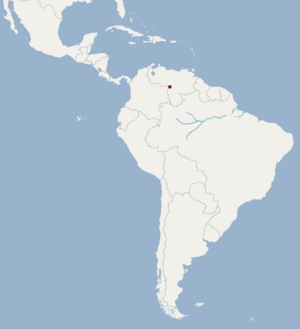Fernandez's sword-nosed bat facts for kids
Quick facts for kids Fernandez's sword-nosed bat |
|
|---|---|
| Conservation status | |
| Scientific classification | |
| Genus: |
Lonchorhina
|
| Species: |
fernandezi
|
 |
|
The Fernandez's sword-nosed bat (Lonchorhina fernandezi) is a special kind of bat. It belongs to a group of bats called Phyllostomidae. This bat is the smallest of all the Lonchorhina sword-nosed bats. You can only find it in Venezuela, which means it is endemic there.
In 2013, a group called Bat Conservation International put this bat on their list of 35 most important species to protect worldwide. This bat is in danger because it is losing its home, which is called habitat loss. Its scientific name comes from a Venezuelan scientist, Dr. Alberto Fernandez Badillo. He studied bats, especially vampire bats.
What Does It Look Like?
These bats are quite small. They weigh about 9.7 to 10 grams, which is like weighing two quarters. Besides being the smallest sword-nosed bat, it also has the simplest nose-leaf. A nose-leaf is a special flap of skin on their nose that helps them use echolocation.
Their skulls are about 17.5 to 17.7 millimeters long. Their fur is dark brown. Each hair is about 6 millimeters long and has two colors: darker at the bottom and lighter at the tip. Their ears are quite long, about 18 to 22 millimeters. Scientists have found a few of these bats that had partial albinism. This means parts of their body were lighter than normal. This bat also has one more bone in its lower back (called a saccral vertebra) than its close relative, the Orinoco sword-nosed bat.
Life and Habits
Scientists don't know much about how these bats have babies. This is because only male bats have been found so far. However, young bats have been seen in February. This suggests that female bats might give birth in December. It's possible that males live in groups called harems during the time they have babies.
Male bats live in groups called colonies. The size of these groups changes throughout the year. They can have anywhere from 1 to 130 bats. Male Fernandez's sword-nosed bats also share their caves with other types of bats. For example, lesser dog-like bats have been seen with them in February, March, and August. In November, Parnell's mustached bats were seen sharing caves with them.
The shape of their wings suggests they can fly very fast and straight. Scientists have looked at what's inside their stomachs. They found that these bats mostly eat beetles and moths. Like many bats, this species can have tiny creatures living on them. These are called ectoparasites, and they include bat flies and wing mites.
Where Do They Live?
The Fernandez's sword-nosed bat is only found in two states in Venezuela: Amazonas and Bolívar. This area is called the Llanos. It has open savanna grasslands with rocky, granite outcrops.
Scientists have studied 45 of these bats, but all of them have been male. This might mean that the female bats live in different places than the males. The places where these bats live are quickly disappearing. This is because the land is being used for cattle ranching. These bats live in groups, forming large gatherings in caves and tunnels.
Protecting These Bats
The Fernandez's sword-nosed bat faces two main dangers. One is the loss of their home because of cattle ranching. The other danger comes from efforts to control vampire bats.
People sometimes try to get rid of vampire bats by blowing up their caves with dynamite. They also use gases like cyanide gas or spread a toxic substance in the caves. These methods are often used without care. This is because local people might not know how to tell the difference between vampire bats and other bats. They might also mistakenly think that all bats drink blood.
In the past, workers from Venezuela's Agriculture and Cattle Ministry have accidentally killed Fernandez's sword-nosed bats. They put poison on all bats they caught, trying to control vampire bats.
To help protect this species, the International Union for Conservation of Nature suggests that their caves should be legally protected. This would stop them from being killed by mistake. They also suggest stopping the expansion of cattle ranching into the areas where these bats live. The Fernandez's sword-nosed bat is listed as endangered. This means there are thought to be fewer than 250 adult bats left in the wild.
See also
 In Spanish: Lonchorhina fernandezi para niños
In Spanish: Lonchorhina fernandezi para niños


